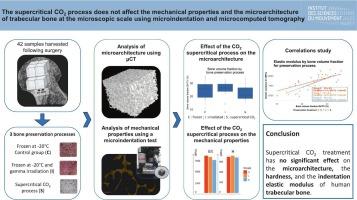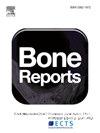超临界CO2过程在微观尺度上不影响骨小梁的力学性能和微结构:微压痕和微计算机断层扫描研究
IF 2.6
Q3 ENDOCRINOLOGY & METABOLISM
引用次数: 0
摘要
同种异体骨移植由于具有骨导电性和骨诱导性,在许多外科手术中经常使用。从供体中取出后,移植物在植入病人体内之前要经过清洁和消毒的处理。虽然它们保证了接受移植物的患者的安全,但保存过程通常会影响骨特性。本研究旨在利用微压痕在微观尺度上测量超临界CO2过程对小梁骨微结构和力学性能的影响。从接受全髋关节置换术的患者中取出7个股骨头。从这些股骨头中取出42个10 mm侧面的立方样品,随机分为3组:- 20°C冷冻、γ辐照和- 20°C冷冻,并进行包括γ辐照在内的超临界CO2处理。所有样品都通过显微断层成像和微压痕表征,以在微观尺度上将骨微结构与力学性能联系起来。结果表明,超临界CO2工艺对微结构参数、压痕弹性模量和压痕硬度没有显著影响。微观结构与力学性能之间的相关性表明,γ辐照似乎会引起力学性能的轻微变化。然而,将超临界CO2处理和伽马射线照射相结合的过程不会比伽马射线照射本身对材料产生更多的改变。因此,超临界CO2过程在微观尺度上对骨小梁力学性能的影响并不大于γ辐照。本文章由计算机程序翻译,如有差异,请以英文原文为准。

The supercritical CO2 process does not affect the mechanical properties and the microarchitecture of trabecular bone at the microscopic scale: A microindentation and microcomputed tomography study
Bone allografts are frequently used in many surgical procedures because of their osteoconductive and osteoinductive properties. After being extracted from the donor, the graft is treated with a process that cleans and sterilizes it before being implanted in the patient. While they guarantee the safety of the patient receiving the graft, preservation processes often affect bone properties.
This study aims to measure the effect of a supercritical CO2 process on the microarchitecture and the mechanical properties of trabecular bone at a microscopic scale using microindentation. 7 femoral heads were harvested from patients who had undergone a total hip arthroplasty. 42 cubic samples of 10 mm side from these femoral heads were randomly distributed in 3 groups: frozen at −20 °C, gamma irradiated and frozen at −20 °C, and treated with a supercritical CO2 process including gamma irradiation. All samples were imaged by microtomography and characterized by microindentation to correlate the bone microarchitecture with the mechanical properties at a microscopic scale.
Our results show that the supercritical CO2 process exerts no significant effect on the microarchitecture parameters, indentation elastic modulus, and indentation hardness.
The correlations between the microarchitecture and the mechanical properties revealed that gamma irradiation appears to induce a slight alteration in mechanical properties. However, the process combining a supercritical CO2 treatment and gamma irradiation does not induce any more alterations to the material than gamma irradiation itself. Thus, the supercritical CO2 process has no more impact than gamma irradiation on the mechanical properties of trabecular bone at the microscopic scale.
求助全文
通过发布文献求助,成功后即可免费获取论文全文。
去求助
来源期刊

Bone Reports
Medicine-Orthopedics and Sports Medicine
CiteScore
4.30
自引率
4.00%
发文量
444
审稿时长
57 days
期刊介绍:
Bone Reports is an interdisciplinary forum for the rapid publication of Original Research Articles and Case Reports across basic, translational and clinical aspects of bone and mineral metabolism. The journal publishes papers that are scientifically sound, with the peer review process focused principally on verifying sound methodologies, and correct data analysis and interpretation. We welcome studies either replicating or failing to replicate a previous study, and null findings. We fulfil a critical and current need to enhance research by publishing reproducibility studies and null findings.
 求助内容:
求助内容: 应助结果提醒方式:
应助结果提醒方式:


